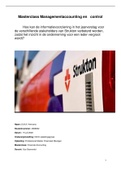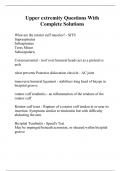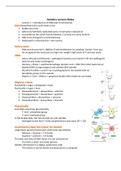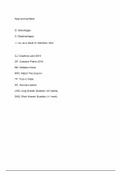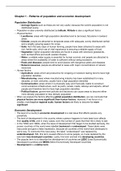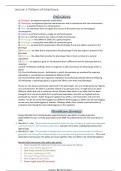OBP Period 5 Master TSCM
Inhoud
Lecture 1: KPI and Quality management.............................................................................3
Performance measures.....................................................................................................3
What is quality?................................................................................................................. 4
Quality and process variation...........................................................................................5
Lecture 2: Statistical techniques in quality management..................................................7
Statistical Process Control...............................................................................................7
Variable............................................................................................................................... 7
Attributes............................................................................................................................ 8
Acceptance Sampling.......................................................................................................9
Operating characteristic curves (Exam)........................................................................10
Instruction class 1...............................................................................................................10
Lecture 3: Multi-Criteria Decision Making I.......................................................................11
Typical questions in Multi-objective decision making..................................................11
A transportation example – the base of all examples today........................................12
Pareto optimal solution...................................................................................................13
How to find good solutions?..........................................................................................13
Weighted Sum Method....................................................................................................13
Achievement scalarisation..............................................................................................14
Epsilon Constraint Method.............................................................................................15
Lecture 4: Multi-Criteria Decision Making II .....................................................................17
Goal programming...........................................................................................................17
Relative importance of the criteria?...............................................................................17
Non preemptive Linear programming model: Two-sided targets................................18
Variants of the model......................................................................................................19
Preemptive linear goal programming: Sequentially......................................................20
Continuous vs. Discrete Problems.................................................................................21
Lecture 5: Multi-Criteria Decision Making III.....................................................................22
Supplier selection problem.............................................................................................22
Ranking methods methods.............................................................................................22
Lp metric method.............................................................................................................23
Rating method.................................................................................................................24
Borda count..................................................................................................................... 24
Pair-wise comparison method........................................................................................25
Dealing with different scales..........................................................................................25
1
,OBP Period 5 Master TSCM
Summary of selection methods......................................................................................26
Lecture 6: Multi-Criteria Decision Making IV.....................................................................28
Analytic hierarchy process.............................................................................................28
Approximative..................................................................................................................29
Consistency ratios...........................................................................................................30
Summary.......................................................................................................................... 31
Lecture 7: DEA: An Introduction to the basic models......................................................32
Introduction to the selection problem............................................................................32
Data Envelopment Analysis (DEA).................................................................................33
Input-orientation vs. Output-orientation........................................................................34
CCR (Charnes, Cooper, Rhodes) model........................................................................35
Formulation example.......................................................................................................35
CCR envelop-form model................................................................................................36
Outcomes of CCR envelop-form model.........................................................................37
Returns to scale: BCC (Banker, Charnes, Cooper) model............................................37
BCC model (output-oriented)..........................................................................................37
Efficient frontier: CCR vs. BCC......................................................................................38
Excersise.......................................................................................................................... 38
Steps prior to using DEA................................................................................................39
Lecture 8: Ranking methods in the DEA context..............................................................40
Efficient – inefficient Models..........................................................................................40
Why ranking?...................................................................................................................40
Ranking methods.............................................................................................................40
Cross efficiency DEA technique.....................................................................................41
Super-efficiency DEA method.........................................................................................42
Disadvantage of the super-efficiency method...............................................................43
2
,OBP Period 5 Master TSCM
Lecture 1: KPI and Quality management
Performance measures
Why do we need performance measurement?
External reasons
Customer requirements (“100% on time delivery required”)
Other external parties (shareholder: inventory turns annual reporting, commercial
purposes)
Internal reasons
CP1: Check Position Know where you are and where you are heading; benchmarking,
monitor progress
CP2: Communicate Position internal communication: e.g. express gratitude, reward
employees
CP3: Confirm Priorities measure distance from desired situation; determination which
actions need to be taken; analysis of strengths and weaknesses
CP4: Compel Progress measure what you need to measure; it is a means for
supporting improvement processes (looking forward)
Popular frameworks:
Balanced Scorecard
The balanced scorecard is a strategic planning and management
system that is used extensively in business and industry,
government, and nonprofit organizations worldwide to align
business activities to the vision and strategy of the organization,
improve internal and external communications, and monitor
organization performance against strategic goals.
However, needs more details to be realistic.
Supply chain operation reference (SCOR)
The SCOR model describes the business activities associated
with satisfying a customer's demand, which include plan,
source, make, deliver, and return. Use of the model includes
analyzing the current state of a company's processes and
goals, quantifying operational performance, and comparing
company performance to benchmark data.
Looks not only at itself but also its suppliers and customers.
Must alter strategy to fit those needs
Behavioral effects of performance measurement
Employees will be influenced by implementation of performance
measurements. Adds to motivation, learn from mistakes and gain
understanding, being watched results in better achievements.
3
, OBP Period 5 Master TSCM
Performance measures can involve different levels of aggregation
Depending on the level within the
organization the level of aggregation
differs. Board of directors take more
overall strategic decisions. Detailed
performance measures are taken
within the lowest region of the
organization.
What is quality?
Everyone defines Quality from their own perspective. Typical responses about the definition
of quality would include: Perfection, Consistency, eliminating waste, Speed of delivery,
Compliance with policies and procedures, doing it right the first time, Delighting or pleasing
customers, Total customer satisfaction and service.
Quality depends on person, context and preference of a person
Is different for everyone, and in each context
Why care about quality
- Increase productivity
- Expand market share
- Raise customer loyalty
- Enhance competitiveness of the firm
- At a minimum: entry barrier
(Defensive) cost of quality, 4 components which add up
4 components:
1. Appraisal costs: costs of inspection, testing, other costs to make product acceptable
2. Prevention costs: costs to prevent defects, costs of inspection, corrective action, train
personnel, redesign system
3. Internal failure: costs for defects (scrap, rework, repair)
4. External failure: cost of defects that pass-through system, customer warranty
replacements, loss of customer goodwill, handling complaints
Cost of quality is scope dependent: costs to make products of minimal versus excellent
quality
Rules of thumb: cost of quality = 15 to 20% of every sales dollar. Each dollar spend in
prevention saves 10 dollars in failure and appraisal costs.
4
Inhoud
Lecture 1: KPI and Quality management.............................................................................3
Performance measures.....................................................................................................3
What is quality?................................................................................................................. 4
Quality and process variation...........................................................................................5
Lecture 2: Statistical techniques in quality management..................................................7
Statistical Process Control...............................................................................................7
Variable............................................................................................................................... 7
Attributes............................................................................................................................ 8
Acceptance Sampling.......................................................................................................9
Operating characteristic curves (Exam)........................................................................10
Instruction class 1...............................................................................................................10
Lecture 3: Multi-Criteria Decision Making I.......................................................................11
Typical questions in Multi-objective decision making..................................................11
A transportation example – the base of all examples today........................................12
Pareto optimal solution...................................................................................................13
How to find good solutions?..........................................................................................13
Weighted Sum Method....................................................................................................13
Achievement scalarisation..............................................................................................14
Epsilon Constraint Method.............................................................................................15
Lecture 4: Multi-Criteria Decision Making II .....................................................................17
Goal programming...........................................................................................................17
Relative importance of the criteria?...............................................................................17
Non preemptive Linear programming model: Two-sided targets................................18
Variants of the model......................................................................................................19
Preemptive linear goal programming: Sequentially......................................................20
Continuous vs. Discrete Problems.................................................................................21
Lecture 5: Multi-Criteria Decision Making III.....................................................................22
Supplier selection problem.............................................................................................22
Ranking methods methods.............................................................................................22
Lp metric method.............................................................................................................23
Rating method.................................................................................................................24
Borda count..................................................................................................................... 24
Pair-wise comparison method........................................................................................25
Dealing with different scales..........................................................................................25
1
,OBP Period 5 Master TSCM
Summary of selection methods......................................................................................26
Lecture 6: Multi-Criteria Decision Making IV.....................................................................28
Analytic hierarchy process.............................................................................................28
Approximative..................................................................................................................29
Consistency ratios...........................................................................................................30
Summary.......................................................................................................................... 31
Lecture 7: DEA: An Introduction to the basic models......................................................32
Introduction to the selection problem............................................................................32
Data Envelopment Analysis (DEA).................................................................................33
Input-orientation vs. Output-orientation........................................................................34
CCR (Charnes, Cooper, Rhodes) model........................................................................35
Formulation example.......................................................................................................35
CCR envelop-form model................................................................................................36
Outcomes of CCR envelop-form model.........................................................................37
Returns to scale: BCC (Banker, Charnes, Cooper) model............................................37
BCC model (output-oriented)..........................................................................................37
Efficient frontier: CCR vs. BCC......................................................................................38
Excersise.......................................................................................................................... 38
Steps prior to using DEA................................................................................................39
Lecture 8: Ranking methods in the DEA context..............................................................40
Efficient – inefficient Models..........................................................................................40
Why ranking?...................................................................................................................40
Ranking methods.............................................................................................................40
Cross efficiency DEA technique.....................................................................................41
Super-efficiency DEA method.........................................................................................42
Disadvantage of the super-efficiency method...............................................................43
2
,OBP Period 5 Master TSCM
Lecture 1: KPI and Quality management
Performance measures
Why do we need performance measurement?
External reasons
Customer requirements (“100% on time delivery required”)
Other external parties (shareholder: inventory turns annual reporting, commercial
purposes)
Internal reasons
CP1: Check Position Know where you are and where you are heading; benchmarking,
monitor progress
CP2: Communicate Position internal communication: e.g. express gratitude, reward
employees
CP3: Confirm Priorities measure distance from desired situation; determination which
actions need to be taken; analysis of strengths and weaknesses
CP4: Compel Progress measure what you need to measure; it is a means for
supporting improvement processes (looking forward)
Popular frameworks:
Balanced Scorecard
The balanced scorecard is a strategic planning and management
system that is used extensively in business and industry,
government, and nonprofit organizations worldwide to align
business activities to the vision and strategy of the organization,
improve internal and external communications, and monitor
organization performance against strategic goals.
However, needs more details to be realistic.
Supply chain operation reference (SCOR)
The SCOR model describes the business activities associated
with satisfying a customer's demand, which include plan,
source, make, deliver, and return. Use of the model includes
analyzing the current state of a company's processes and
goals, quantifying operational performance, and comparing
company performance to benchmark data.
Looks not only at itself but also its suppliers and customers.
Must alter strategy to fit those needs
Behavioral effects of performance measurement
Employees will be influenced by implementation of performance
measurements. Adds to motivation, learn from mistakes and gain
understanding, being watched results in better achievements.
3
, OBP Period 5 Master TSCM
Performance measures can involve different levels of aggregation
Depending on the level within the
organization the level of aggregation
differs. Board of directors take more
overall strategic decisions. Detailed
performance measures are taken
within the lowest region of the
organization.
What is quality?
Everyone defines Quality from their own perspective. Typical responses about the definition
of quality would include: Perfection, Consistency, eliminating waste, Speed of delivery,
Compliance with policies and procedures, doing it right the first time, Delighting or pleasing
customers, Total customer satisfaction and service.
Quality depends on person, context and preference of a person
Is different for everyone, and in each context
Why care about quality
- Increase productivity
- Expand market share
- Raise customer loyalty
- Enhance competitiveness of the firm
- At a minimum: entry barrier
(Defensive) cost of quality, 4 components which add up
4 components:
1. Appraisal costs: costs of inspection, testing, other costs to make product acceptable
2. Prevention costs: costs to prevent defects, costs of inspection, corrective action, train
personnel, redesign system
3. Internal failure: costs for defects (scrap, rework, repair)
4. External failure: cost of defects that pass-through system, customer warranty
replacements, loss of customer goodwill, handling complaints
Cost of quality is scope dependent: costs to make products of minimal versus excellent
quality
Rules of thumb: cost of quality = 15 to 20% of every sales dollar. Each dollar spend in
prevention saves 10 dollars in failure and appraisal costs.
4


